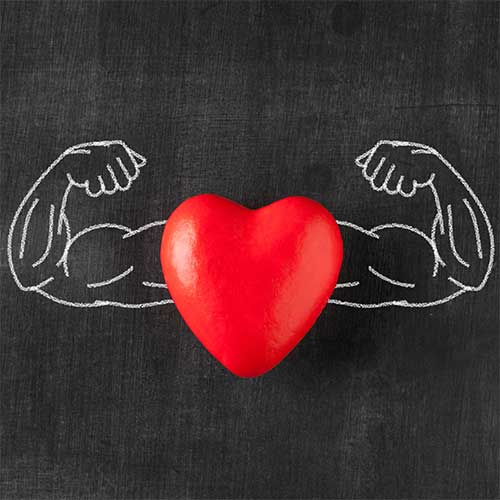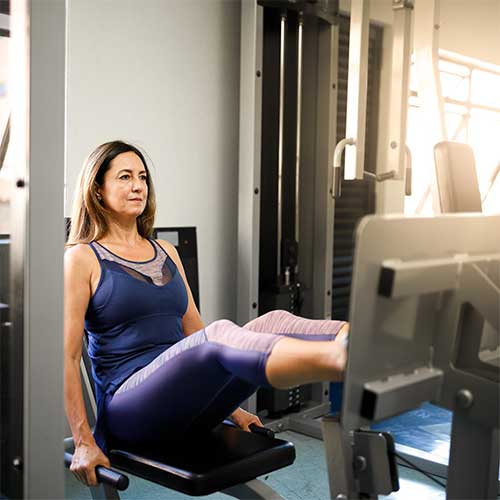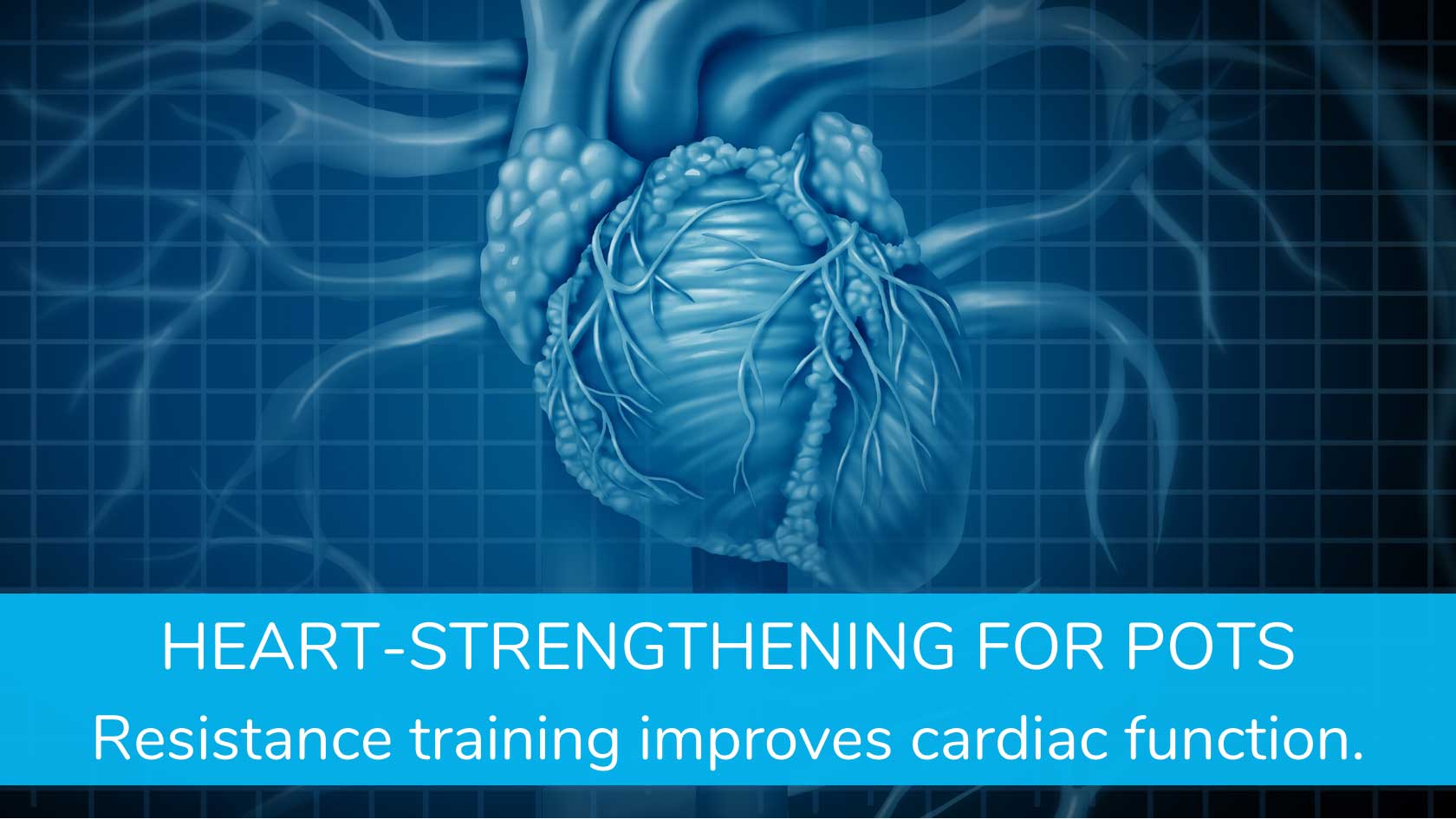This is the second article in a series on resistance training for EDS and POTS. It is not medical advice and is presented for informational purposes only. Consult with your medical provider before adopting any exercise program.
Foreword: Clarifications and Updates Albert Einstein said that things should be made as simple as possible, but no simpler. Failing to heed this advice, I initially made little mention of autonomic dysfunction in this article. It wasn’t my intention to deny that POTS is primarily an impairment of the nervous system. Instead, it was to ask the question: “How can exercise help someone with POTS?” To that end, I put a heavy emphasis on heart strengthening, not because heart weakness is the primary cause of all POTS cases, but rather because it is a common finding in those with the condition, and because exercise interventions which cause improvements in heart muscle mass are strongly associated with improvement in symptoms. To add clarity, I have revised some of my phrasing to make clear that this is not an all inclusive way to treat POTS, but rather a look specifically at how exercise can be a benefit to those with the condition.
Maintaining blood flow to the brain is complex.
When we stand from a chair or bed, it takes the coordinated action of our cardiovascular system to ensure that the blood in our head doesn’t rush to our feet, causing us become dizzy or faint. This process of preserving flow to the brain involves both pressure sensors in our arteries and dynamic control of our “cardiac output,” or the rate and volume/force of our heart beats.
As the body needs increased pressure, the heart can increase its output in two ways:
1 – increasing heart rate, or how fast the heart beats.
2 – increasing stroke volume, or how much blood is moved with each beat.
When the heart is strong enough, it can use both strategies to deliver blood to the brain, because larger stroke volumes mean more forceful heartbeats.
What is POTS (Postural Orthostatic Tachycardia Syndrome)
But in people with POTS (Postural Tachycardia Syndrome), it is very common the heart muscle is often not strong enough to pump harder to meet demands. Though primarily associated with central (CNS) and autonomic (ANS) nervous system dysfunction, low heart muscle volume/thickness is a common finding in this population.
Due to a combination of CNS/ANS dysfunction, and low heart muscle strength, POTS sufferers often can’t tolerate standing for long periods, and position changes can be difficult for them to manage without feeling lightheaded or unwell. Though multifactorial, POTS seems to be related to heart muscle size and strength in many patients.. When the heart can’t pump harder due to less muscle mass, the only way to increase output is to try to beat faster. The heart rate in patients with POTS can become elevated so significantly when they rise from lying or sitting that it actually becomes inefficient, as there isn’t enough time between beats for the heart to fill completely. As a result, blood flow to the brain drops, resulting in lightheadedness, dizziness, nausea, headaches, and other very uncomfortable symptoms.

In this article, I want to discuss both how to mitigate these problems during exercise, and how the right type of exercise may actually help to resolve some of the symptoms of POTS. Crucially, I am not suggesting that exercise can reliably cure what may largely be driven by CNS and ANS dysfunction. Instead, I am interested in whether exercise can help these patients, and if so, what form of exercise is most beneficial.
What type of exercise can strengthen the hearts of POTS sufferers?
In his pivotal review paper “The Isometric Athlete,” the late John Longhurst, MD, PhD escribed the special adaptations that isometric exercise confers. A preeminent cardiologist with over 250 publications, Dr. Longhurts’s research showed that in athletes who must sustain muscular tension for extended periods, such as climbers or wrestlers, the heart is placed under a unique type of stress that is unlike rhythmic activities such as running, cycling, or swimming.
Luckily, there are ways to achieve these benefits WITHOUT having to wrestle or rock climb.

Repetitive “cardio” may not address the cardiovascular impairments typical with POTS.
With rhythmic activities, the contracting and relaxing muscles of the arms and legs help pump blood rapidly back to the heart. The result is that the heart has to deal with a steady influx of blood, and must struggle to keep up, essentially like baling water. This confers many useful adaptations, and for my fellow geeks, these improvements can be termed “eccentric” strengthening. But for people with POTS, whose hearts may struggle to beat strongly due to the high prevalence of low heart muscle thickness, we are probably better served by focusing our efforts on a different approach – continuous tension training, which includes isometrics. With resistance training exercise, whether performed motionless (isometrics) or under a slow but continuous tension, blood flow through the working muscles is severely restricted because the pressure inside contracting muscles is so high. The muscle is producing so much internal pressure just to maintain tension that it’s very hard for blood to get into the muscle. As a result, instead of frantically trying to keep up with rapidly moving blood, the heart has to try to pump blood through resistance, and it gets physically stronger.
Resistance training with Continuous Tension helps our hearts grow stronger.
In his paper, Dr. Longhurst describes the very specialized adaptations that isometric athletes experience in their hearts and how they are different from what aerobic athletes achieve, though highly beneficial in their own rights. With isometrics, and by extension any slow-strength training exercise in which muscular tension is sustained for longer periods, the heart grows stronger and thicker in response to the increased pressures it must fight against to deliver blood to working muscles. This is why those with POTS can benefit from strength training, and particularly from doing their resistance exercises with a very slow and controlled motion. The tension placed on the muscles forces the heart to have to adapt by producing more forceful contractions, rather than simply producing faster beats. Because the tension is sustained for longer times, (ideally from 1-3 minutes), the heart gets a unique conditioning effect as it is challenged to pump blood slowly but forcefully. As a result, the heart becomes stronger, and this improved strength allows the body to increase blood flow more efficiently in response to a position change.

POTS severity can be significantly lessened with a safe program of resistance training.
As patients with POTS perform this type of exercise, the strengthening of their hearts means that when they change postures, their heart at least has the option to beat harder, instead of only being able to beat faster, which allows them to deliver blood to their brains more effectively. Instead of a racing, inefficient heart, their bodies can have an easier time maintaining optimal function with a slower, stronger heart rate.
In one very important study in the Journal of the American College of Cardiology, Fu et al found that a combined program of resistance training and recumbent “cardiovascular” exercise improved heart muscle mass, and thus improved stroke volume (the amount of blood pumped with each beat), which enabled the heart to improve it’s output. As a result, many of the study participants improved their condition so much that they no longer clinically had POTS by the end of the study!
Now I know what you’re thinking – safe resistance training can help, but what if I can’t even do it due to my POTS? Let’s talk about how exercise can be made tolerable
How to avoid exacerbating your POTS during exercise.
Many traditional strengthening exercises involve positional change. Lunges, squats, deadlifts, and other exercises can be very beneficial when properly instructed, but they also involve raising and lowering the center of gravity. This change in posture and body angle can elicit POTS symptoms. This leaves us with two main ways to train:
1 – Perform motionless (isometric) exercises while sitting or lying down.
2 – Perform slowly moving (continuous tension) exercises while sitting using machines.
The first and simplest thing we can do is to find ways to avoid position change during exercise. Though traditional leg exercises can be part of a healthy strength training routine, if they consistently cause tachycardia and lightheadedness, we need better options.
Machines allow us to strength train while sitting, and allow us to achieve high efforts safely.
Leg presses and other leg machines offer us the ability to maximally fatigue and strengthen the large muscles of the lower body without position change. Chest press and pulldown machines do the same for the trunk and upper body. And when these machines are made well, they enable use to move the weight slowly, without rest breaks in between reps, so that muscular tension stays high, challenging the heart to grow stronger.
As a result, a person with POTS can reach optimal levels of muscular tension and fatigue, and thus stimulate more improvements in strength, while remaining in a sitting position. By avoiding flaring their symptoms with positional changes during exercise, they can make it possible to stick to a productive routine.

If good machines aren’t available, isometrics are the next best option.
If you don’t have access to a full suite of seated resistance training machines like those found at StrengthSpace, a home routine can be a decent starting point until you do gain access to such equipment, or until your symptoms resolve enough to allow you to use more traditional exercises. The most important concept to adopt with all of these exercises is to maintain muscular tension for as long as possible. The longer we hold motionless against gravity with exercises like glute bridges, planks, wall-sits, or dumbbell holds in different positions, the harder our hearts must work to overcome the pressure in the muscles.
Keep tension constant and effort high to strengthen the heart.
Additionally, even with moderate weights, holding motionless for long enough can produce so much muscular fatigue that the body “feels” like it is holding much heavier weights than it is. A common myth is that only very heavy weights help us grow stronger, but the fact is that longer sets with moderately challenging weights can produce similar benefits. As fatigue grows, effort grows, and it is effort that matters, not absolute weight.
If you’d like a great example of how safe and challenging an isometric routine can look alike, watch this clip by the prolific author and strength training researcher Ken Hutchins, who has pioneered many innovations for strength training around musculoskeletal conditions. In the video, he puts a client through an isometric workout in which the client gradually ramps up his exertion to a near maximal effort at the end of each exercise. By ramping up slowly, he produces so much fatigue that his muscles are too tired to cause a strain at the end.
Conclusion
For our clients with POTS, we see the research play out in real life: just 20-30 minutes of resistance exercise performed twice a week considerably improves the strength not only of their skeletal muscles, but of their hearts as well. I want to re-emphasize that this doesn’t mean exercise can “cure” POTS, which is a multifactorial disorder involving CNS/ANS dysfunction. But the benefits of exercise for POTS patients are strongly demonstration, and in this article I have offered a hypothesis about what may be happening in the heart of a POTS patient whose symptoms improve with exercise. If we can understand why exercise helps, we can more specifically target the particular training approach that can produce the adaptations we desire.
And given that this approach to resistance training is ideally suited for people who also suffer from Ehlers-Danlos Hypermobility Disorder due to it’s low-force nature and high emphasis on safety, it remains my primary strategy for helping sufferers of both conditions to feel better. Developing more strength in both the cardiac and skeletal muscle can serve as an important part of the management of POTS, of course in conjunction with a person’s treatment team including their medical doctor and physical therapist.

